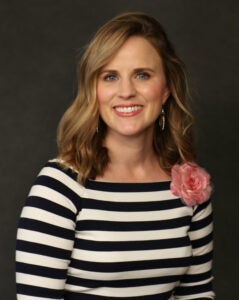Create a culture that means business™
Email address
 Meet Lauren Brittingham
Meet Lauren Brittingham
Director of Organizational Development, Bayhealth Medical Center
Lauren Brittingham is the Director of Organizational Development at Bayhealth Medical Center, a not-for-profit healthcare system with more than 3,700 employees. Seven years ago, Lauren was hired by Bayhealth Medical Center to focus on “special projects” for the Human Resources (HR) department. She has grown a successful career in HR ever since, climbing up the ranks to director-level at Bayhealth Medical Center. With a Master’s Degree in Public Administration (with a concentration in Health Policy) and seven years of HR experience in her back pocket from Bayhealth Medical Center, she is well equipped to make a powerful impact on Bayhealth Medical Center’s culture and employee experience.
When it comes to the employee experience, Lauren’s biggest focus is making employees feel valued, respected, and appreciated. She truly believes that no matter how small a job is or how junior an employee might be, every job is important in helping an organization run effectively and efficiently. Creating a positive employee experience isn’t always easy and doesn’t always come with immediate support from frontline employees or leaders, but Lauren makes it her priority to ensure every employee is working towards creating a positive experience. After all, an unbeatable employee experience is what keeps employees wanting to come back to work and put their best foot forward.
Let’s take a moment to recognize Lauren
We want to take a moment to recognize Lauren for her accomplishments in employee engagement. Below, she answers a series of questions, providing advice for fellow HR professionals and sharing her personal story.
1. What interested you in a career in HR?
I initially took a job offer to work on “special projects” on the Human Resources team at Bayhealth Medical Center as my foot in the door to the healthcare industry. While I thought my placement in HR would be temporary and I would find a different role elsewhere in the organization, I found myself gaining more and more responsibility. Within my first year at Bayhealth Medical Center, I updated close to fifty HR policies, managed the employee engagement survey, and was promoted to a manager role which required me to oversee the front-of-house operations and workers’ compensation program. I found my work interesting; instead of focusing on creating policies and programs to help patients, I was creating policies and programs to support healthcare workers, who in turn care for patients – a spin on my initial career goal of wanting to work in Health Policy, but a very important one at that. Each year I gained more responsibility in the HR department, including recognition and rewards, employee relations, and organizational development. I felt very connected to my work in HR and gladly took on new projects. In February 2018, I was promoted to Director of Organizational Development at Bayhealth Medical Center.
2. What is your biggest culture challenge and how do you overcome it?
At our organization, we have a lot of employees and leaders who have worked at Bayhealth Medical Center for a long time (20+ years) and many employees whose only work experience is at Bayhealth Medical Center. These long-term employees are very in tuned with the organization’s history and often compare previous work experiences or benefits to new initiatives. While working to overcome this challenge requires constant focus, we try our best to explain the “why” behind new initiatives by incorporating facts about industry standards, economic trends, and the changing workforce. We also tailor our communication style to speak specifically to certain generations. Overcoming this challenge isn’t easy, but providing the “why” behind the “what” provides transparency to help earn trust from our employees and shows that there is a strong business reason as to why we may be changing some things in our organization.
3. What is the key to boosting employee engagement across your organization?
The main key to boosting employee engagement across Bayhealth Medical Center is having every leader aligned and making sure they each own their engagement strategy. If leaders don’t own their engagement strategy, they won’t support the need for change. When employees don’t see or feel change in the workplace, they will continue to be disengaged and feel like their voice isn’t being heard. And it doesn’t just stop there, clients and patients will feel the disengagement from your employees as well. This reminds me of a Harvard Business Review article titled, “Reminder: Customers Care How You Treat Your Employee.”
4. What is your favorite employee recognition moment at Bayhealth Medical Center?
My favorite moment was when we implemented Driven, our recognition and rewards program powered by Achievers. We put a lot of effort into the program’s rollout, including going to hospitals during night shifts to encourage employees to sign up and start participating in the program. We even passed out stickers of the program’s logo for employees to wear. It was fun seeing employees walk around our hospitals wearing Driven stickers and scrolling through tons of recognitions on Driven’s newsfeed as soon as the program launched.
You could feel the excitement from the employees for our new recognition and rewards program.
This excitement continues to live on today, with Driven remaining a very active platform and recognition being spread across the organization on a regular basis.
5. Where do you see the future of employee engagement heading?
As we know, millennials are taking over the workforce (yes, yes we are!). Millennials are coached, as I even remember being coached in college, to not settle for the first offer of employment, negotiate salary, and look for benefits that support work-life balance. Gone are the days of employees being loyal to one organization from teenage years all the way to retirement. The future of engagement depends on recognizing these changes in the workforce (like it or not) and embracing them. What worked for one generation won’t work for another. Employees may be asking for more, but it doesn’t mean you have to give more – you just need to be more flexible. If you don’t recognize the changing workforce and apply necessary changes, your business will fail to keep up with competitors as a result.
6. What would be your top three pieces of advice for an HR professional who is looking to implement an employee engagement strategy at their organization?
#1: Understand who you are addressing in your employee population as well as the clients you serve. What job roles are represented? What is the generational breakdown? What is the range of tenure with the organization? How will engagement strategies affect clients and employees, positively or negatively? Knowing these details are important when it comes to tailoring your message and strategic plan.
#2: Sometimes implementing engagement strategies elicit strong emotions and pushback from others in the organization; this includes everyone from frontline employees to leadership. Remember to focus on what the overall goal is and remind yourself that changes are not personal. Just because one thing has worked in an organization for 40 years does not mean it will work forever. Coaching leaders to embrace change is important in continuing your journey to further enhance engagement.
#3: Focus on what keeps your employees engaged AND your customers engaged. Focusing too heavily on one end of the spectrum instead of looking at both can leave your organization feeling like a) the employee doesn’t matter, or b) the customer doesn’t matter. Understanding the needs from both groups can help you determine how to approach engagement initiatives with employees while still delivering the best experience to your customers and vice versa.
Looking ahead
What’s next for Lauren? She and the Bayhealth Medical Center team are continuing to look at what they can do within the organization to further enhance and increase employee engagement. They are continuously improving everything from benefits and work-life balance to recognition and rewards. Lauren is also involving leaders more than ever before in engagement programs. By involving leadership more in engagement initiatives, leaders have higher accountability to connect with their staff and promote a work culture that truly engages employees.
About Bayhealth Medical Center’s recognition program
Bayhealth Medical Center’s employee recognition program, powered by Achievers, caters to 3,700 employees across central and southern Delaware. Since launch in 2015, the program has seen a 95% activation rate, 75% monthly active usage, and 19,500 leader-sent recognitions in 2018.
To learn more about the award-winning platform that powers Bayhealth Medical Center’s recognition program, sign up for a demo of Achievers today.

 Meet Lauren Brittingham
Meet Lauren Brittingham
